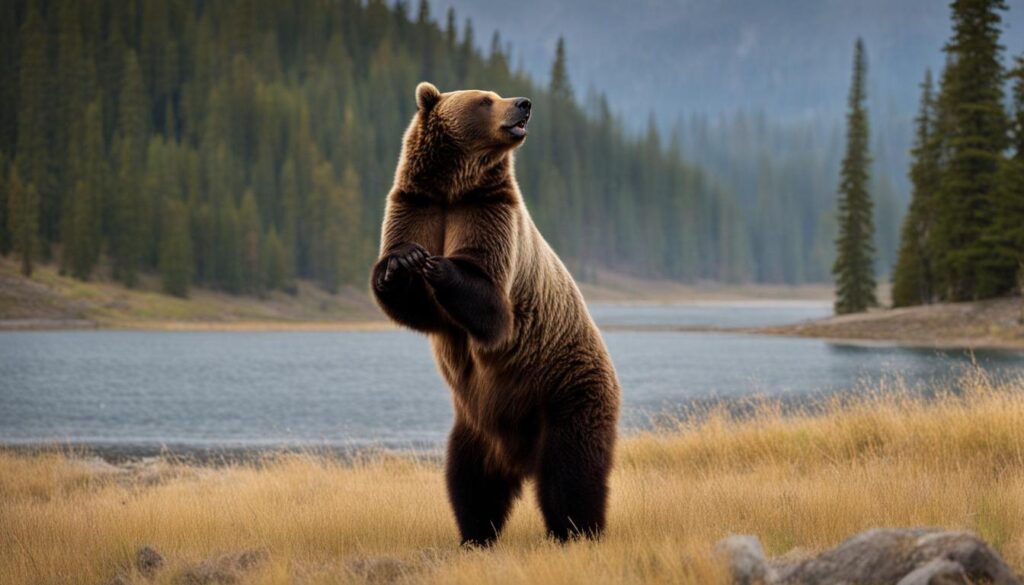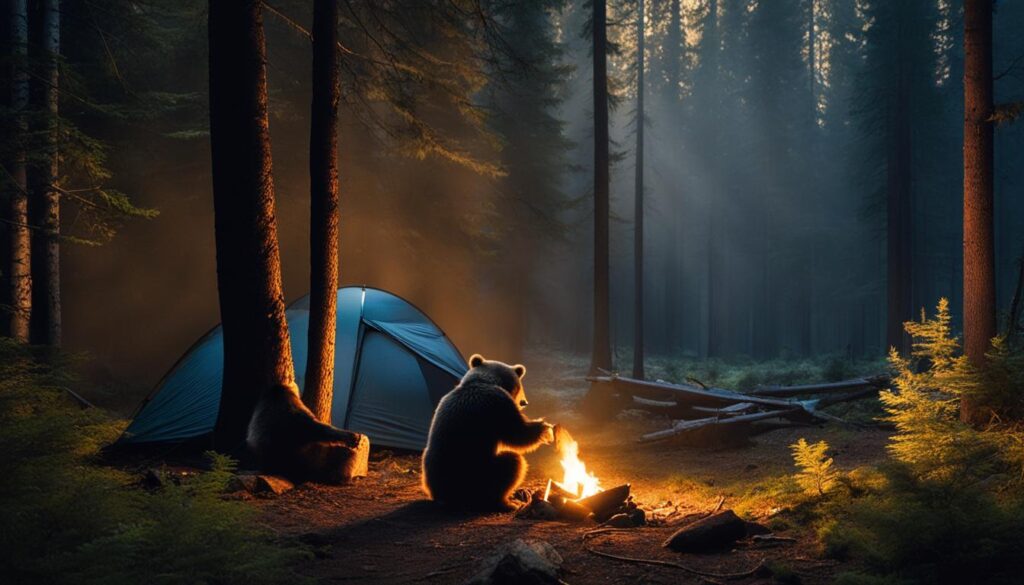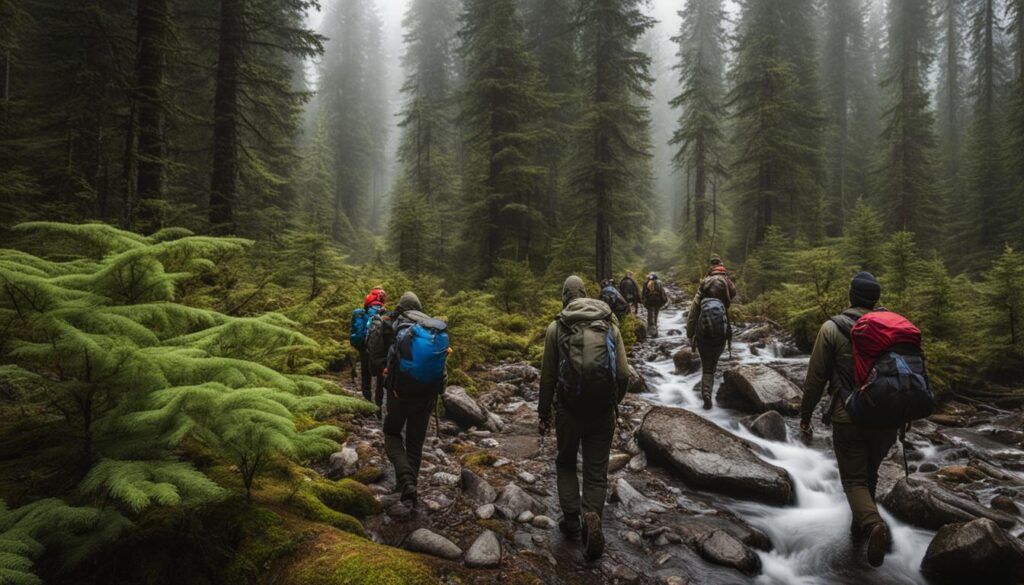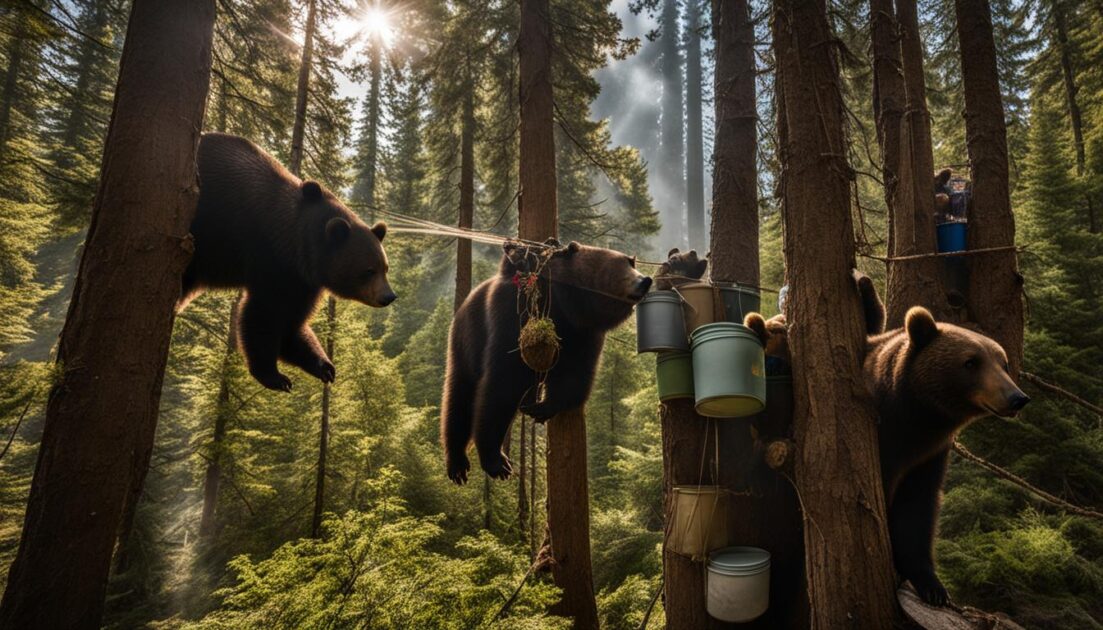As an outdoor enthusiast and experienced camper, I know how crucial it is to prioritize safety when venturing into bear country. Understanding bear behavior and taking necessary precautions are essential for campers to keep bears away and ensure a safe camping experience. In this article, I will share valuable insights on bear safety tips, prevention strategies, and general guidelines to help you navigate the wilderness with confidence.
Key Takeaways:
- Learn how to prevent bear encounters and maintain a safe distance when camping.
- Understand the behavior of different bear species prevalent in North America.
- Follow important safety measures such as proper food storage and campsite selection.
- Take extra precautions when hiking in bear country and know how to respond in a bear encounter.
- Prioritize safety and respect for bears to ensure a harmonious coexistence in their natural habitat.
Types of Bears and Their Behavior
When camping in bear country, it’s important to understand the different types of bears and their behavior. In North America, the two most common types of bears are black bears and grizzly bears. Let’s take a closer look at these bears and how they behave.
Black Bears
Black bears are widely distributed throughout the United States and are known for their adaptability to various habitats. They are smaller than grizzly bears, with adult males weighing between 200 and 600 pounds. These bears have a diverse diet that includes berries, nuts, insects, and even carrion. Despite their name, black bears can also be brown, cinnamon, or blonde in color.
When encountering humans, black bears typically exhibit timid behavior and may try to avoid contact. However, they can become more aggressive if they feel threatened, especially if they have cubs. It’s crucial to remember that black bears are powerful animals and should never be approached or fed.
Grizzly Bears
Grizzly bears, also known as brown bears, are predominantly found in specific regions of North America, including Alaska, Montana, and Wyoming. They are larger than black bears, with adult males weighing between 500 and 1,200 pounds. Grizzly bears have a more varied diet, which includes fish, plants, fruits, and occasionally large mammals.
Unlike black bears, grizzly bears have a more assertive behavior and are known to be more protective of their territory. They can be unpredictable when encountered and may display defensive behavior if they feel threatened. It’s important to give grizzly bears a wide berth and never intentionally approach them.
Understanding the behavior of black bears and grizzly bears is essential for campers to avoid bear encounters and ensure their safety in the wilderness.
To summarize:
| Bear Type | Characteristics | Territory |
|---|---|---|
| Black Bears | Smaller size, diverse diet, timid behavior | Throughout the United States |
| Grizzly Bears | Larger size, varied diet, assertive behavior | Specific regions of North America |
With an understanding of black bears and grizzly bears, campers can take appropriate precautions and minimize the risk of bear encounters. Remember to always respect bears’ natural habitat and follow bear safety guidelines to ensure a safe and enjoyable camping experience.

Bear Safety Measures for Campers
To ensure a safe camping experience and prevent bear encounters, it is essential for campers to follow important safety measures. By implementing these precautions, you can minimize the risk of attracting bears to your campsite and reduce the chance of bear-human conflicts. Here are some key bear safety measures every camper should be aware of:
1. Proper Food Storage
One of the primary ways to avoid attracting bears to your campsite is by properly storing your food. Bears have an exceptional sense of smell and can be enticed by the scent of food from miles away. To prevent them from entering your campsite, store all food, garbage, and scented items in bear-resistant containers or hang them from a tree at least 10 feet above the ground and 4 feet away from the trunk. This will significantly reduce the risk of bears accessing your food and lingering around your campsite.
2. Leave No Trace Principles
Practicing Leave No Trace principles is not only vital for preserving the natural environment but also for minimizing interactions with bears. Leave No Trace encourages campers to minimize their impact on nature by disposing of waste properly, camping on durable surfaces, and leaving natural objects undisturbed. By following these principles, you can help maintain a clean campsite that is less attractive to bears.
3. Carry Bear Spray
Bear spray is a highly effective deterrent that can help defend against bear attacks. It is a non-lethal option that creates a cloud of pepper spray, temporarily incapacitating the bear and giving you a chance to retreat. Before heading into bear country, make sure to familiarize yourself with how to use bear spray correctly and keep it easily accessible, such as attaching it to your belt or backpack. Remember, bear spray should never be a substitute for bear awareness and precautionary measures.
4. Select a Safe Campsite
Choosing an appropriate campsite is crucial for reducing the likelihood of bears coming into close proximity with your camp. Look for a location away from bear attractants, such as berry patches or animal carcasses. Additionally, avoid camping near trails that may be frequented by bears. Setting up camp near a water source, like a river or lake, can also help deter bears as they are less likely to approach areas with high human activity.
5. Bear Awareness
Being aware of bear behavior and signs of their activity is essential for camping safely in bear country. Educate yourself about bear behaviors and the precautions necessary for minimizing risks. Pay attention to bear signs, such as fresh tracks or scat, and be cautious when hiking or exploring in areas where bears may frequent. By staying alert and informed, you can take proactive measures to avoid unexpected encounters with bears.

| Safety Measure | Description |
|---|---|
| Proper Food Storage | Store food, garbage, and scented items in bear-resistant containers or hang them from a tree |
| Leave No Trace Principles | Minimize impact on nature by disposing of waste properly and leaving natural objects undisturbed |
| Carry Bear Spray | Non-lethal deterrent to defend against bear attacks |
| Select a Safe Campsite | Choose a location away from bear attractants and frequented by humans |
| Bear Awareness | Stay informed about bear behavior and signs of activity in the area |
Tips for Hiking in Bear Country
Hiking in bear country can be an exhilarating experience, but it also requires extra precautions to ensure your safety. By following these hiking safety tips and bear encounter prevention strategies, you can minimize the risk of bear encounters and enjoy your hike with peace of mind.
1. Hike in Groups
One of the most effective ways to prevent bear encounters is to hike in groups. Bears are less likely to approach larger groups of people, so try to hike with at least three or more individuals. Stick together and maintain close proximity, especially in dense vegetation or areas with limited visibility.
2. Make Noise
When hiking in bear country, make noise to alert bears of your presence. Talk, sing, or clap your hands at regular intervals. This will help avoid surprising bears, as they will most likely move away when they hear human sounds.
3. Stay Cautious around Blind Turns and Limited Visibility Areas
Be extra cautious when hiking near blind turns, dense vegetation, or areas with limited visibility. Slow down, scan the surroundings, and make additional noise to avoid surprising a bear or stumbling upon a feeding or resting area.
4. Be Aware of Bear Activity Signs
Keep an eye out for signs of bear activity while hiking, such as tracks, scat, overturned rocks or logs, and claw marks on trees. These indicators can signal the presence of bears in the area, allowing you to adjust your path or take extra precautions.
5. Maintain Situational Awareness
Always stay alert and maintain good situational awareness while hiking in bear country. Be observant of your surroundings, pay attention to any potential bear signs, and avoid distractions such as loud music or headphones. By staying vigilant, you can react promptly if you encounter a bear.
6. Know How to Respond in a Bear Encounter
It is crucial to know how to respond if you encounter a bear during your hike. The best course of action may vary depending on the species of bear and the circumstances. Generally, it is recommended to slowly back away while speaking calmly and firmly, avoiding direct eye contact with the bear. Do not turn your back on the bear or run, as this may trigger a chase response.
Remember, hiking in bear country comes with its own set of responsibilities. By following these hiking safety tips and bear encounter prevention strategies, you can enjoy the beauty of the wilderness while minimizing the risk of bear encounters.

Bear Safety during Camping
When camping in bear country, prioritizing camping safety and following specific bear safety precautions is crucial for both campers and bears. Bears are attracted to food odors and can pose a threat to campers if precautions are not taken. To ensure a safe camping experience, there are several important measures campers should take.
First and foremost, it is essential to properly store food in bear-resistant containers or hang it at a safe distance from the campsite. This prevents bears from accessing the food and keeps them from becoming habituated to human food sources. Additionally, campers should maintain a clean campsite, disposing of garbage properly and cleaning up any food scraps or cooking residue.
Another important bear safety precaution is to avoid sleeping outside or with any food odors in the tent. Bears have an exceptional sense of smell and can be attracted to the scent of food, so it is important to keep the sleeping area odor-free. Sleeping in a tent provides an extra layer of protection in case of a bear encounter.
Lastly, being prepared for a bear encounter is crucial. Campers should familiarize themselves with bear safety guidelines and know how to respond appropriately. This includes knowing how to use bear spray effectively and understanding the signs of bear behavior. It is important to show respect for bears’ natural habitat and to remember that we are guests in their territory.
FAQ
How can I keep bears away when camping?
To keep bears away when camping, follow these tips:
1. Properly store food to prevent attracting bears.
2. Practice leave no trace principles.
3. Carry bear spray for protection.
4. Select a safe campsite away from bear attractants.
5. Be aware of bear behavior and signs of activity while hiking or exploring.
What should I do if I encounter a bear?
If you encounter a bear while camping, follow these guidelines:
1. Stay calm and avoid sudden movements.
2. Do not run, as it may trigger a chase response.
3. Give the bear space and try to back away slowly.
4. Speak calmly and firmly to let the bear know you are human.
5. If the bear approaches, stand your ground and make yourself look bigger by raising your arms or opening your jacket.
6. If the bear charges, use bear spray as a deterrent.
What are the general guidelines for camping in bear country?
When camping in bear country, follow these precautions:
1. Properly store food in bear-resistant containers or hang it at a safe distance.
2. Keep a clean campsite to avoid attracting bears.
3. Avoid sleeping outside or with any food odors in the tent.
4. Be prepared for a bear encounter by knowing how to respond appropriately.
5. Respect bears and prioritize their safety and the harmony of their natural habitat.
How can I prevent bear encounters while hiking?
To prevent bear encounters while hiking, take these safety measures:
1. Hike in groups, as bears are less likely to approach larger groups.
2. Make noise to alert bears of your presence and avoid surprising them.
3. Be cautious around blind turns or areas with limited visibility.
4. Be aware of signs of bear activity such as tracks and scat.
5. Maintain good situational awareness and be prepared to respond appropriately if you encounter a bear.
What are bear-resistant camping techniques?
Bear-resistant camping techniques include:
1. Using bear-resistant containers for food storage.
2. Hanging food at a safe distance from the campsite.
3. Keeping a clean campsite to minimize food odors.
4. Avoiding sleeping outside or with any food odors in the tent.
5. Being aware of bear behavior and taking necessary precautions to prevent attracting them.
Feel free to suggest any modifications or improvements to the FAQ section.

